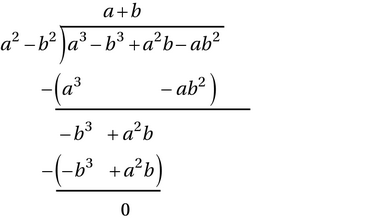PSAT Math Multiple-Choice Question 662: Answer and Explanation
Question: 662
 equals which of the following, given that a ≠ ±b ?
equals which of the following, given that a ≠ ±b ?
- A. a + b
- B. a - b
- C. a2b - ab2
- D. a2 + b2
Correct Answer: A
Explanation:
(A) From all of the answer choices, we can see that the whole denominator cancels out somehow. Let's use polynomial long division to figure out an equivalent expression for our original fraction. Before we use long division, let's first combine like terms in the numerator so that the long division isn't as complicated:
a3 - b3 + 2a2b - 2ab2 + ab2 - ba2 = a3 - b3 + a2b - ab2
Now do polynomial long division:

Thus, our original fraction is equal to a + b, which is choice (A).
Alternatively, you could have simplified directly by factoring. Since a3 - b3 = (a - b)(a2 + ab + b2), we can rewrite the numerator:
a3 - b3 + 2a2b - 2ab2 + ab2 - ba2 = a3 - b3 + a2b - ab2 = (a - b)(a2 + ab + b2) + a2b - ab2
Notice that a2b - ab2 = ab(a - b), so our numerator becomes:
(a - b)(a2 + ab + b2) + a2b - ab2 = (a - b)(a2 + ab + b2) + ab(a - b) =
(a - b)(a2 + ab + b2 + ab) = (a - b)(a2 + 2ab + b2) = (a - b)(a + b)2
Thus, our original fraction can be rewritten as  . Since our denominator is a difference of squares, it can be rewritten as a2 - b2 = (a + b)(a - b). Our entire expression becomes:
. Since our denominator is a difference of squares, it can be rewritten as a2 - b2 = (a + b)(a - b). Our entire expression becomes:

Choice (A) is correct.
Test Information
- Use your browser's back button to return to your test results.
- Do more Math Multiple-Choice Tests tests.
More Tests
- PSAT Math Multiple-Choice Test 1
- PSAT Math Multiple-Choice Test 2
- PSAT Math Multiple-Choice Test 3
- PSAT Math Multiple-Choice Test 4
- PSAT Math Multiple-Choice Test 5
- PSAT Math Multiple-Choice Test 6
- PSAT Math Multiple-Choice Test 7
- PSAT Math Multiple-Choice Test 8
- PSAT Math Multiple-Choice Test 9
- PSAT Math Multiple-Choice Test 10
- PSAT Math Multiple-Choice Test 11
- PSAT Math Multiple-Choice Test 12
- PSAT Math Multiple-Choice Test 13
- PSAT Math Multiple-Choice Test 14
- PSAT Math Multiple-Choice Test 15
- PSAT Math Multiple-Choice Test 16
- PSAT Math Multiple-Choice Test 17
- PSAT Math Multiple-Choice Test 18
- PSAT Math Multiple-Choice Test 19
- PSAT Math Multiple-Choice Test 20
- PSAT Math Multiple-Choice Test 21
- PSAT Math Multiple-Choice Test 22
- PSAT Math Multiple-Choice Test 23
- PSAT Math Multiple-Choice Test 24
- PSAT Math Multiple-Choice Test 25